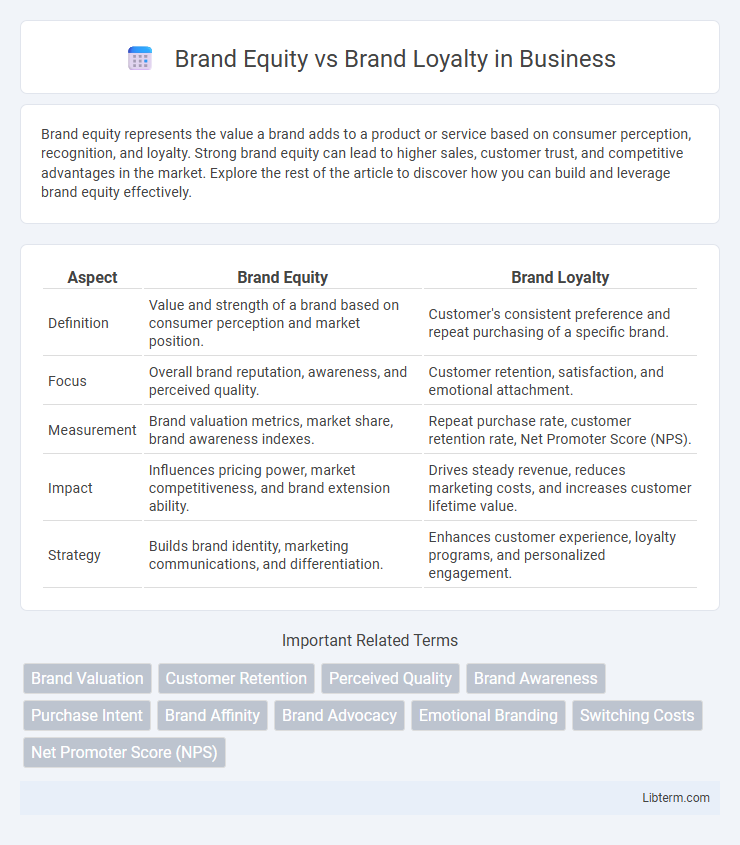Brand equity represents the value a brand adds to a product or service based on consumer perception, recognition, and loyalty. Strong brand equity can lead to higher sales, customer trust, and competitive advantages in the market. Explore the rest of the article to discover how you can build and leverage brand equity effectively.
Table of Comparison
| Aspect | Brand Equity | Brand Loyalty |
|---|---|---|
| Definition | Value and strength of a brand based on consumer perception and market position. | Customer's consistent preference and repeat purchasing of a specific brand. |
| Focus | Overall brand reputation, awareness, and perceived quality. | Customer retention, satisfaction, and emotional attachment. |
| Measurement | Brand valuation metrics, market share, brand awareness indexes. | Repeat purchase rate, customer retention rate, Net Promoter Score (NPS). |
| Impact | Influences pricing power, market competitiveness, and brand extension ability. | Drives steady revenue, reduces marketing costs, and increases customer lifetime value. |
| Strategy | Builds brand identity, marketing communications, and differentiation. | Enhances customer experience, loyalty programs, and personalized engagement. |
Understanding Brand Equity
Brand equity represents the overall value and strength of a brand in the marketplace, driven by consumer perceptions, brand awareness, and emotional connections. It encompasses tangible and intangible assets, such as brand recognition, perceived quality, and customer associations, which influence purchasing decisions and pricing power. Understanding brand equity helps businesses develop strategies to enhance long-term competitive advantage and market positioning.
Defining Brand Loyalty
Brand loyalty refers to a consumer's consistent preference and repeated purchase of a specific brand over time, driven by positive experiences and emotional connection. It reflects the degree of attachment and commitment a customer has towards a brand, often resulting in reduced sensitivity to price or competitive offers. Measuring brand loyalty involves tracking repeat purchase rates, customer retention, and net promoter scores, which indicate long-term brand value beyond immediate sales.
Key Differences Between Brand Equity and Brand Loyalty
Brand equity represents the overall value and perception of a brand in the market, encompassing brand awareness, associations, perceived quality, and customer experiences. Brand loyalty specifically refers to consumers' consistent preference and repeat purchasing behavior toward a particular brand. Key differences include brand equity's broader impact on market value and competitive advantage, while brand loyalty directly influences customer retention and long-term sales stability.
Components of Brand Equity
Brand equity comprises key components such as brand awareness, perceived quality, brand associations, and brand loyalty. Each element contributes to the overall value and strength of the brand in the marketplace, influencing customer preference and pricing power. Brand loyalty specifically represents the degree of attachment customers have toward a brand, acting as both a component and an outcome of strong brand equity.
Factors Influencing Brand Loyalty
Brand loyalty is influenced by factors such as customer satisfaction, perceived value, product quality, and emotional connection to the brand. Consistent positive experiences and trust in the brand enhance repeat purchases and advocacy behavior, strengthening loyalty over time. Marketing efforts like personalized communication, loyalty programs, and reliable customer service are also critical in fostering long-term brand loyalty.
The Role of Perception in Brand Equity
Brand equity is fundamentally shaped by consumer perception, encompassing the value, trust, and emotional connections linked to a brand, which in turn influence market position and pricing power. Unlike brand loyalty, which reflects repeat purchasing behavior driven by satisfaction and habit, brand equity's strength lies in positive consumer associations and perceived quality. Understanding and managing these perceptions are critical for building sustainable brand value and competitive advantage.
How Brand Loyalty Drives Customer Retention
Brand loyalty significantly drives customer retention by fostering repeated purchases and reducing churn rates, which enhances a company's long-term profitability. Loyal customers often advocate for the brand, increasing organic growth through word-of-mouth marketing and strengthening brand equity over time. High brand loyalty creates a competitive advantage, making customers less sensitive to price changes and more resistant to competitors' offers.
Measuring Brand Equity vs Brand Loyalty
Measuring brand equity involves assessing consumer perceptions, brand awareness, and overall market value through metrics like brand recognition, perceived quality, and brand associations. Brand loyalty measurement focuses on customer retention rates, repeat purchase behavior, and customer lifetime value, reflecting the strength of consumer commitment to a brand. Quantitative data from surveys, purchase frequency, and Net Promoter Scores (NPS) are essential in distinguishing between the financial and emotional dimensions of brand equity and loyalty.
Strategies to Improve Both Brand Equity and Brand Loyalty
Effective strategies to enhance brand equity and brand loyalty include delivering consistent high-quality products that meet customer expectations and fostering emotional connections through personalized marketing campaigns. Implementing a robust customer feedback system and leveraging social proof, such as testimonials and influencer endorsements, build trust and credibility. Investing in brand storytelling and loyalty programs incentivizes repeat purchases while reinforcing the brand's unique value proposition to strengthen long-term consumer commitment.
Impact of Brand Equity and Loyalty on Business Success
Brand equity significantly enhances business success by increasing customer trust, enabling premium pricing, and fostering strong market positioning. Brand loyalty drives repeat purchases and customer retention, which lowers marketing costs and boosts long-term revenue stability. Together, high brand equity and loyal customers create a competitive advantage, sustaining profitability and growth in dynamic markets.
Brand Equity Infographic

 libterm.com
libterm.com